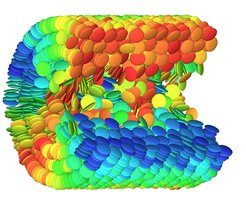Go Nano – Ringstructures for the Future
In nanopores, liquid crystals arrange themselves in tree rings
Since the second half of the 20th century liquid crystals have found their way into almost every modern household. Whether it's a computer, TV or tablet: liquid crystals have become an integral part of our everyday life. These substances are highly valued for their ability of self-organization. They repeatedly show a very surprising behavior and many laboratories all around the world are constantly finding new ways to exploit the flexibility of liquid crystals. These materials still hold great potential for future applications. Researchers Arne Zantop and Marco Mazza from the Max Planck Institute for Dynamics and Self-Organization in Göttingen have discovered a new liquid crystal property: In a confined space, their molecules organize themselves into ring-shaped structures which causes a gradual change in their state of matter. The researchers present their findings in the current issue of the journal "Physical Review Letters".
When things get tight

The theoretical and experimental collaboration of the Göttingen scientists from the Max-Planck-Institute for Dynamics and Self-Organization (MPIDS) with the Technical University of Hamburg (TUHH) and the German Electron Synchrotron Research Center (DESY) shows a stepwise temperature dependent transition that accompanies the self-assembly of liquid-crystalline molecules. In order to do that, the physicists put the liquid-crystalline molecules into contact with a nanoporous silicate glass. The pores are tiny cylindrical openings in the material, only a few millionths of a millimeter wide. Normally, the coin-like molecules of the examined liquid crystal arrange themselves in long columns, which look like the stacks of casino chips. For the first time the researchers show that when pushed into a tight space, the molecules assemble layer-by-layer starting from the pore walls towards the pore center without any external influence.
The nanopore starts to look similar to the ring structure of a tree trunk. “The combination of symmetry and confinement gives rise to unexpected, new phase transitions”, says Marco Mazza from the Max Planck Institute for Dynamics and Self-Organization in Göttingen, who led the theoretical work. Mazza's colleague, Arne Zantop devised a theoretical and numerical model for the nanoconfined liquid crystals that contributed a lot to the confirmation and interpretation of the experimental results.
Layer by layer - transitions make it possible
Physicists speak of phase transitions, when temperature or pressure variations cause corresponding changes in the state of matter of certain materials. Some of these transformations are very common. For instance, we all know that water solidifies into ice when the temperature drops below 0ºC, that a piece of lead melts when we hold it over the candle flame on New Year‘s Eve and that our glasses get steamed up when we come home on a cold winter‘s day. In case of the liquid-crystalline rings, the gradual cooling of the material ensures that previously disordered molecules are arranged into layers in a step-by-step way and form a new structure. Each new layer is created at a certain temperature and even small temperature variations can activate or deactivate the formation of new nanorings. “This change of the molecular structure in confined liquid crystals can be monitored with X-ray diffraction methods as a function of temperature and with high accuracy”, says DESY scientist Milena Lippmann.
This rarely observed, near-room-temperature controllable phase transition provides an easily tunable method for the self-organization of a new optical metamaterial. “This phenomenon constitutes a fine example how versatile soft matter can adapt to extreme spatial constraints and how confinement provides new design and control principles for the self-organization of functional nanomaterials” says Kathrin Sentker from TUHH who conducted the experimental study in the group of Patrick Huber. Scientists hope that the discovery of such a peculiar self-arrangement can have multiple ways of the industrial realization. Besides the temperature-controlled optical metamaterials, a new application in organic semiconductors is also imaginable, such as temperature-switchable self-organized nanowires. “This unusual disc-arrangement could improve modern electronic devices, and make them more efficient and environmentally friendly”, says MPI researcher Marco Mazza.
